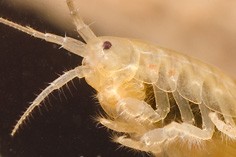Scuds or side-swimmers
Feeding:
Collectors/gatherers/shredders/predators – scuds are omnivores and eat just about any organic material they come upon.
Habitat:
Scuds mostly occur in shallow regions of both running and still waters.
Movement:
Scuds crawl at the bottom or swim in the position on the side or upside down.
Size:
Body length of scuds ranges from 5 mm to 20 mm (without antennae).
Life cycle:
There is no separate larval stage. Young look like small adults and become sexually mature after growing and shedding their skin several times.
Introduction:
Scuds (or side-swimmers) are freshwater invertebrates belonging to the order Amphipoda. The common name side-swimmer comes from the way that these animals swim, as like the name scud, which has its origins in Norwegian.
Scuds live at the bottoms of many types and sizes of habitats, where they occur in spaces between the stones, roots, or tangles of vegetation. The most common they are in shallow areas of streams, rivers, ponds, or lakes (in a depths not exceeding one meter). Large numbers can be found in habitats, which are small to have fish populations. Some species are adapted to live in saline waters, hot springs, or underground waters of caves.
Scuds also lack carapace, but their hard covering of chitin is reinforced by the presence of calcium carbonate in its structure. Segmented body is flattened from side to side and divided into three groups: cephalothorax, thorax, and abdomen.
Cephalothorax consists of the head and the first thoracic segment. There are two pairs of antennae (insects have one pair). Eyes are sessile cluster of ocelli, in contrast to crayfish, crabs, or shrimps having eyes placed on stalks.
Next seven segments (each with pair of legs) form the thorax. First and second pairs of legs have enlarged ends, equipped with hinged claws. They are used for grasping food and to assist in crawling or mating. Five remaining pairs of legs end with a simple pointed claw.
Abdomen consists of the rear six segments. Each abdominal segment has a pair of shorter and simpler appendages for swimming.
Egg development, hatching and the first molts take place within the female brood pouch on the underside of thorax. Young are released when the female next molts and look like small adults.
Scuds or side-swimmers (Gammaridae):

















